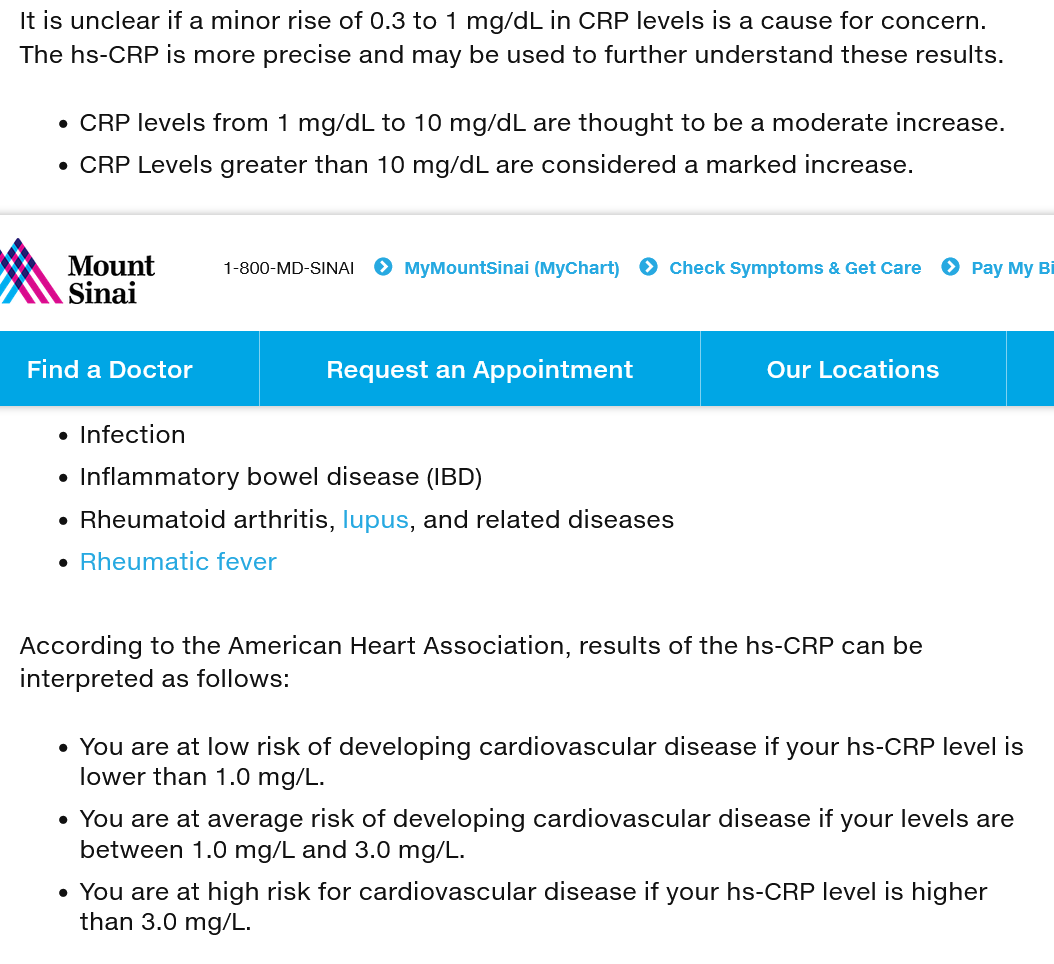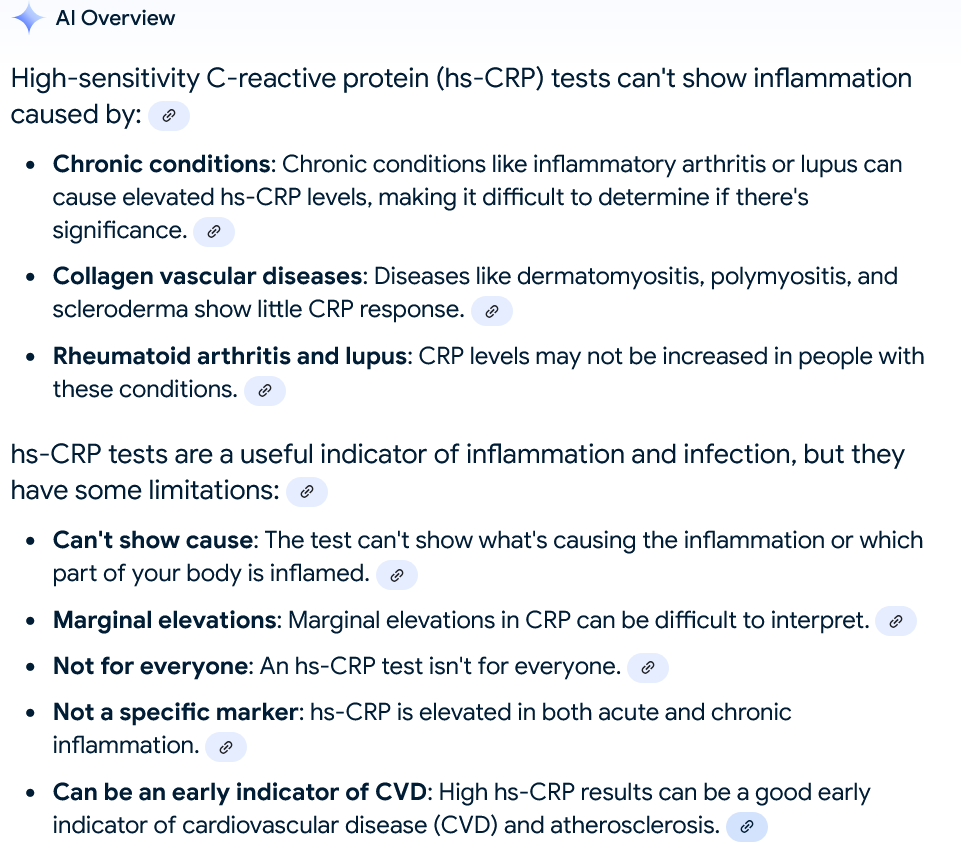I’d consider a low fibrinogen to be a good thing, indicating low level of inflammation, so long as the HsCRP was also low. This is inducible - when you need it, you can pump it out quickly within 24-48 hours. I’d rather have a low than normal level myself.
I would check the units on your CRP.
An aside @ng0rge but I am fascinated by your CRP readings. The standard level of precision for hsCRP is in the range of 0.01 to 0.1 mg/L, depending on the assay used and a value of 0.50 falls in the lowest decile for a male your age. Assuming no error, do you know what you are doing to achieve this level, probably in the lowest 0.1% of the distribution? What is your IL-6 score? Congratulations are in order. I do a lot to lower my inflammation markers and have been very happy with values in the 0.25 area.
I have not encountered a lab that can measure below 0.15mg/l. Sometimes labs report in mg/dl, however.
I do not have enough personal data to know but I was able to learn that the lower limits of precision range from 0.01 (presumably that is +/- 0.01) all the way up to 0.1, depending on the lab and method. I would think that most modern labs are achieving 0.01. Scientific convention suggests that labs should either not report scores to the hundredth or there should be an asterisk, especially at the lower end of the range.
A correction to what I stated above. For a 70 year old male:
- 0.5 mg/L would place an individual in the lowest 25% of the distribution.
- 0.25 mg/L would place an individual in the lowest 10%.
These figures are approximate and extrapolated from:
- Median hsCRP: Around 1.5–2.0 mg/L.
- Interquartile range: Typically spans from 0.5 mg/L to 3.0 mg/L.
I’m not certain of the quality of this data but it seems plausible other than the median for a 70 year old man being a bit lower than I would have expected.
Yes, John, we covered this in another thread. And when I looked, I saw the difference in units - mg/dL vs mg/L - so my low HsCRP (.05 mg/dL) isn’t low compared to yours. I assumed it was a difference in units between Europe and the US, but now I’m not sure. A google search said this:
" AI Overview
Learn more…
High-sensitivity C-reactive protein (hs-CRP) is usually reported in milligrams per deciliter (mg/dL)."
And gave this link:
https://www.ncbi.nlm.nih.gov/books/NBK441843/
Lab values vary, and there is no standard at present. However, in general, the result is reported in either mg/dL or mg/L. Hs-CRP is usually reported in mg/dL.
But I also saw this…where it switches almost mid-sentence without explanation.
What I’m most interested in, is what the different inflammation markers - HsCRP, IL-6, fibrinogen, TNF-a, MPO, ESR, GlycA, Lp-PLA2 have that is unique to that one marker and won’t be shown by the other markers. For example, if I have low HsCRP (by whatever units), do I need to worry that I may have inflammation that HsCRP is not picking up? OK, I know, google is my friend…
It’s a difference in units.
I would be interested in your source of data for a 70 year old male.
Yes
John, with your very low HsCRP score, what other inflammation markers do you check with your blood tests, and what do they tell you that HsCRP doesn’t?
I see that TNF-a costs $94 USD at Marek and IL-6 costs $75 USD at Life Extension ($185 USD at Marek), so what do they tell you that HsCRP doesn’t?
ESR seems the cheapest and certainly with the home tester unit shown above, the easiest. But it also looks less sensitive.
It was an interpolation @John_Hemming based on NHANES (including Ford’s article based on it: Ford et al., 2003, "C-Reactive Protein Concentration Distribution Among US Adults), Framingham, Health ABC, CHS, and Rotterdam. I have been interested in CRP as a potentially highly leveraged health metric. These numbers seem reasonable although the variance between them is not a small as I would like to see it.
As I said above my HsCRP in mg/L would be .5 mg/L (sorry for the confusion on units), so…
While that seems good, it could be better. I guess it means I have some inflammation.
I’m exploring this subject more as I believe that inflammation, blood sugar, senescent cells and circulatory health - as well as epigenetics - are the critical factors in longevity.
Again, what do you think IL-6 or TNF-a tells you, that is actionable, if your HsCRP is low?
I focus on CRP. I dont add to the panel that much, but ferritin is interesting.
Could you please provide a link to this?
Very interesting, that the background level for HsCRP (no infection) correlates with the level of senescent cells, and that citrate supplementation can reduce both.
The mistake people make in measuring CRP is not to ensure they are measuring the background CRP. It goes up massively with infection.
@ng0rge: I think you and others are correct in thinking that you can typically (usually) just monitor CRP and take action if you see a problem. The downsides with that approach as I see it include:
IL-6 is an upstream cytokine that stimulates the liver to produce CRP, so they are mechanistically linked. However, IL-6 reflects more chronic, low-grade inflammation and vascular injury earlier in the inflammatory cascade, while hs-CRP primarily reacts to acute-phase responses. IL-6 captures inflammation before CRP rises, providing earlier and potentially different information.
Ferritin is an acute-phase reactant like CRP but is also linked to iron metabolism and oxidative stress. It can rise in response to inflammation but not as quickly as CRP.
Ferritin offers insight into chronic inflammation and may be elevated in conditions with metabolic and oxidative components (e.g., metabolic syndrome, liver disease), even when CRP is not. It is less sensitive to short-term fluctuations but reflects longer-term trends in systemic inflammation.
Fibrinogen and CRP are acute-phase reactants is often elevated in inflammation, particularly in response to IL-6 (similar to CRP). However, fibrinogen is also involved in coagulation and thrombosis. While CRP signals inflammation broadly, fibrinogen reflects the pro-thrombotic state linked to cardiovascular events. Elevated fibrinogen is a risk factor for blood clot formation and is directly involved in the pathology of atherosclerosis.
TNF-α is another cytokine that can drive inflammation and is involved in both systemic and localized inflammatory responses. It plays a role in initiating and sustaining chronic inflammation, particularly in vascular tissues. While CRP reflects systemic inflammation, TNF-α gives insight into chronic and tissue-specific inflammatory processes, especially in vascular beds, making it more relevant to understanding ongoing, vascular-specific inflammation.
Finally and somewhat in summary. CRP is robust in sensitivity but not so in specificity.
This is very interesting @John_Hemming. Assuming the causal relationship between senescent cells (I’m assuming dysfunctional types, not all are), how, in practical terms, does one assess a given CRP metric adjusting for the contribution of interfering senescent cells?

